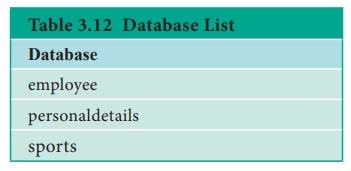Database Management System (DBMS) - Designing Databases | 12th Computer Applications : Chapter 3 : Introduction to Database Management System (DBMS)
Chapter: 12th Computer Applications : Chapter 3 : Introduction to Database Management System (DBMS)
Designing Databases
Designing
Databases
The process of creating, implementing and
maintaining the enterprise data in a system is known as Designing of databases.
Better understanding of the application is necessary before designing the
database. The performance and success of an application depends on good
database design. MySQL provides performance dashboard, reports and statistics
regarding the design of database.
Create Conceptual Design
It is the primary phase in database design, where
detailed discussion about the creation of databases, tables, columns and data
types is discussed based on the requirement of the application. As an end
result the model is framed to attain the expectation of the application’s end
user.
• Create Database
The three major parts that forms a database are
Tables, Queries and Views.
Tables - similar
to an excel sheet, containing
multiple rows and columns. Where each row is a record and each column is an
attribute.
Queries – It is a
question with multiple conditions
posted to the database. The records in the database that satisfies the passed
conditions are retrieved.
Views – A set
of stored queries.
Example: create
a database to store the personaldetails.
mysql> create database
personaldetails;
Query Ok, 1 row affected
mysql> USE personaldetails;
Database changed.
The created database is listed using SHOW command. See Table 3.12
mysql> show databases;

Database List
Database: employee, personaldetails, sports
• Create Table
In an application, each page reveals some
functionality. Each such functions are designed to a table. For example, in an
online shopping site like Amazon, multiple pages are maintained like customer
profile, products, orders in cart and payment page. All these can be created as
tables like Customer, Products, Order and Payment respectively.
• Create Columns
Each table will have many columns related to the
functionality of the table. This column determines what values are stored in
the table. For example, the Customer table contains the columns like firstname,
lastname, phone, email, age, address and pincode. These columns hold the
Customer information in the table. Each column is assigned with appropriate
value type. The efficiency and performance of the table purely depends on the
data types assigned to the columns.
• Insert Rows
Once the database is created, tables and the
columns with the appropriate value type are defined. Then records are inserted
to the table.
INSERT
INTO TABLE_NAME (column1, column2, column3, ... columnN)
VALUES
(value1, value2, value3, ...valueN);
Related Topics